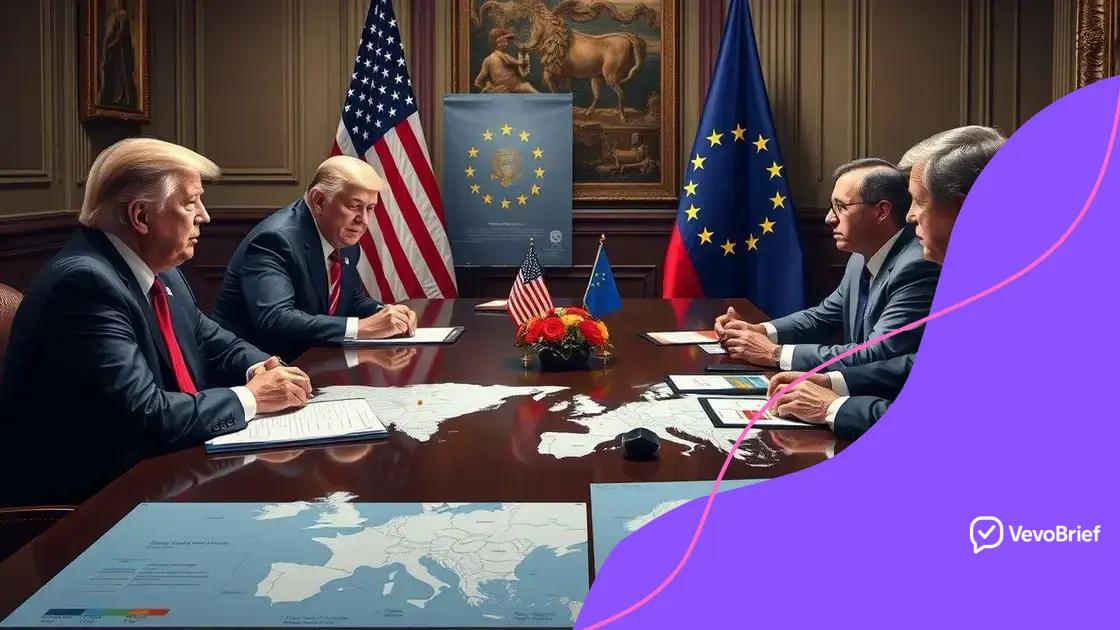Secretary of State’s Eastern Europe diplomatic efforts explained

The Secretary of State’s diplomatic efforts in Eastern Europe focus on strengthening alliances, promoting economic ties, and addressing geopolitical challenges to foster regional stability and growth.
Secretary of State’s Eastern Europe diplomatic efforts reveal a complex landscape of international relations. Have you ever wondered how these efforts shape the region’s stability? Let’s explore.
The historical context of Eastern Europe diplomacy
The historical context of Eastern Europe diplomacy is rich and complex. Understanding this background is essential for grasping current international dynamics. Eastern Europe has seen countless transformations, influenced by periods of conflict, shifting borders, and varying alliances.
Key Historical Events
Several key events have shaped the diplomatic landscape in Eastern Europe. These events often intertwine, creating a narrative that’s vital for comprehending contemporary issues.
- The fall of the Berlin Wall in 1989 marked a significant shift towards democracy and freedom across the region.
- The dissolution of the Soviet Union in 1991 led to the emergence of independent states, each navigating their own paths.
- Key expansions of NATO in the early 2000s reinvigorated Western interests and diplomatic relations with former Soviet states.
In addition to these events, other factors influence diplomacy in today’s Eastern Europe. Economic challenges, ethnic tensions, and external influences play substantial roles. Nations are balancing their historical ties and modern aspirations. As a result, dialogue among countries can be intricate.
Influence of Historical Alliances
Throughout history, alliances have shifted dramatically within Eastern Europe, impacting diplomatic relations. The Warsaw Pact established a Soviet-dominated bloc, while NATO provided a counterbalance, especially after the Cold War. This interplay continues to affect how countries communicate and negotiate.
Additionally, the European Union has become a pivotal player in fostering unity and stability in the region. Many Eastern European countries aspire toward EU membership, viewing it as a pathway to economic growth and political security. However, the process is not without challenges, as discussions around reforms and adherence to EU standards continue.
Key initiatives by the Secretary of State
Key initiatives by the Secretary of State play a crucial role in shaping diplomatic relations in Eastern Europe. These initiatives are often designed to address emerging challenges and strengthen partnerships with countries in this region.
Diplomatic Engagements
The Secretary of State actively engages with Eastern European leaders, working to build trust and foster open communication. Regular meetings and visits to the region help in understanding local concerns and priorities.
- Hosting roundtable discussions with regional leaders
- Participating in joint military exercises to enhance security collaboration
- Promoting economic partnerships through trade agreements
These diplomatic engagements have unique benefits. They not only create opportunities for dialogue but also strengthen alliances. Furthermore, they allow the Secretary of State to advocate for democracy and human rights, which are often under threat in various Eastern European countries.
Development Assistance Programs
In addition to direct diplomacy, the Secretary of State oversees several development assistance programs aimed at boosting stability. These programs can provide essential support for economic growth and infrastructure development.
- Funding educational initiatives to promote social progress
- Investing in energy projects to reduce dependency on foreign sources
- Supporting governance reforms to enhance democratic institutions
By investing in such areas, the U.S. aims to empower Eastern European nations to build resilient societies. These initiatives encourage self-sufficiency and enable countries to tackle their challenges effectively. The impact is significant, fostering not just economic development but also social cohesion.
Impact on U.S.-European relations

The impact on U.S.-European relations is significant, especially in the context of Eastern Europe. As the Secretary of State engages with these countries, the ripple effects are felt across the Atlantic. Strengthening ties with Eastern Europe can benefit both the U.S. and its European allies.
Strengthening Alliances
One of the major benefits of these diplomatic efforts is the strengthening of alliances. By supporting Eastern European nations, the U.S. helps to fortify their security. This, in turn, enhances collective security for Europe as a whole.
- Encouraging regional cooperation among Eastern European nations
- Bolstering defenses against external threats
- Promoting shared democratic values and principles
Such strategies create a united front and foster a sense of stability in a region that has seen conflict and change. The U.S. commitment to Eastern Europe signals to Europe that its interests are aligned, further solidifying transatlantic relations.
Economic Ties
Another important aspect is the economic ties that develop from these initiatives. By fostering economic growth in Eastern Europe, the U.S. supports its European partners. When Eastern European countries thrive economically, they become more robust trading partners.
- Increased trade opportunities between the U.S. and European nations
- Encouragement of investments in Eastern European markets
- Creation of jobs in both the U.S. and Europe as a result of trade agreements
These economic benefits lead to a more interconnected and prosperous region, which directly impacts U.S.-European relations. As countries in Eastern Europe become more stable and prosperous, they contribute to the overall strength of the European Union and NATO.
Challenges faced in diplomatic efforts
Challenges faced in diplomatic efforts toward Eastern Europe can be complex and multifaceted. Despite good intentions, the path to successful diplomacy is often filled with obstacles that require careful navigation.
Geopolitical Tensions
One significant challenge arises from geopolitical tensions. The historical legacy of conflicts in the region continues to influence current relations. Nations may have competing interests, making consensus difficult.
- Conflicting interests between Russia and Western nations
- Nationalism and regional disputes
- Pressure from third-party countries influencing local politics
These geopolitical factors can hinder effective dialogue and negotiation. They necessitate a nuanced understanding of each country’s historical context and current aspirations.
Economic Limitations
Furthermore, economic limitations pose another hurdle. Many Eastern European countries face structural economic challenges that impact their ability to engage fully in diplomatic efforts. Issues like unemployment and inflation can create instability.
- Dependence on external funding and support
- Economic disparities within the region
- Limited resources for development projects
Such economic challenges can affect political stability and the potential for constructive dialogue. Assisting these nations economically becomes crucial for promoting healthier diplomatic relations.
Internal Political Dynamics
In addition, internal political dynamics can complicate diplomatic initiatives. Governments may experience shifts that affect their foreign policy direction. Populist movements or leadership changes can lead to unpredictable outcomes.
- Varying attitudes towards foreign influence
- Political disagreements within coalition governments
- Public opposition to certain diplomatic initiatives
These internal challenges can disrupt ongoing negotiations and alter the course of established relationships. As the situation evolves, adaptability becomes key for effective diplomacy.
Future prospects for Eastern Europe diplomacy
The future prospects for Eastern Europe diplomacy present both opportunities and challenges. As the global landscape continues to evolve, diplomatic efforts in this region will be crucial for maintaining stability and growth.
Strengthening European Union Relations
One vital aspect is the potential for strengthening relations within the European Union. As Eastern European nations seek to align more closely with EU standards, there is room for growth and integration.
- Enhancing cooperation on security and defense issues
- Encouraging economic partnerships within the EU framework
- Promoting democratic values and reforms
These developments can lead to a more unified Europe. A stronger EU can help buffer against external pressures, ensuring that Eastern European countries can thrive while safeguarding their sovereignty.
Increased U.S. Engagement
Another important factor is the likelihood of increased U.S. engagement. As global tensions rise, the U.S. may prioritize its diplomatic relations with Eastern Europe to counterbalance other powers.
- Expanding military cooperation and training programs
- Boosting economic investments and trade agreements
- Supporting civil society and democratic institutions
This kind of engagement can empower Eastern European countries while establishing a solid foundation for future cooperation. Enhanced ties with the U.S. can also attract more investments from private sectors, promoting innovation and growth.
Adapting to Changing Global Dynamics
Additionally, Eastern Europe must adapt to changing global dynamics. Factors like climate change and technology will shape the future of diplomacy. Countries in the region may focus on sustainable practices and digital innovation as part of their diplomatic strategies.
- Collaborating on environmental protection initiatives
- Investing in technology and cybersecurity
- Creating partnerships around renewable energy sources
By proactively addressing these challenges, Eastern European countries can position themselves as leaders in global discussions on pressing issues. The future of diplomacy in this region will require flexibility and a willingness to forge new paths.
FAQ – Frequently Asked Questions about the Secretary of State’s Eastern Europe Diplomatic Efforts
What are the main goals of the Secretary of State’s diplomatic efforts in Eastern Europe?
The main goals include strengthening alliances, promoting economic ties, and enhancing regional stability.
How do geopolitical tensions affect diplomatic relations in Eastern Europe?
Geopolitical tensions create challenges as nations may have competing interests, making cooperation more complex.
What role does the European Union play in Eastern Europe’s diplomatic efforts?
The EU promotes integration and cooperation, helping Eastern European countries align with democratic values and economic standards.
What future prospects exist for Eastern European diplomacy?
Future prospects include increased U.S. engagement, strengthening EU relations, and addressing climate and technological challenges.
